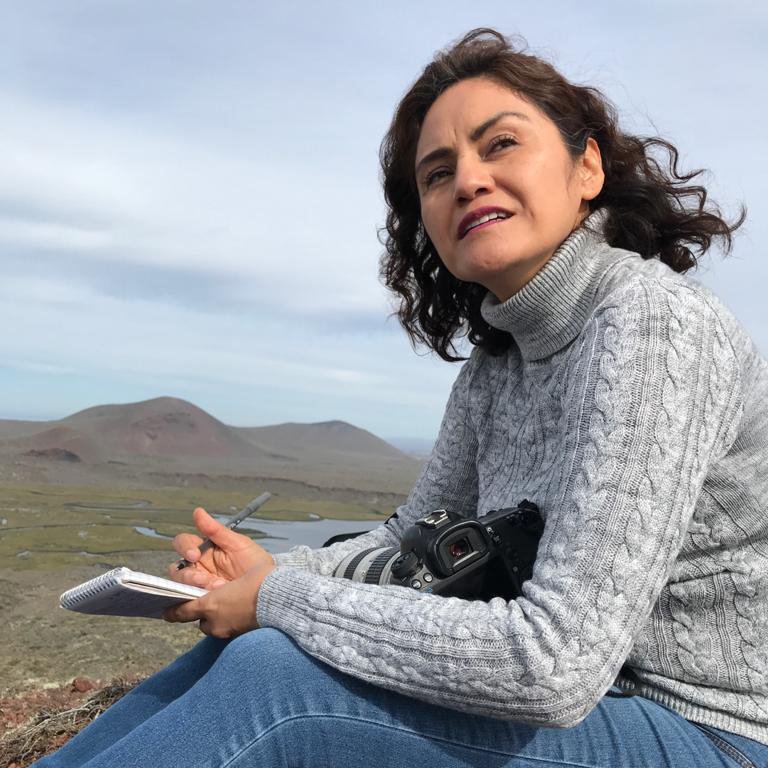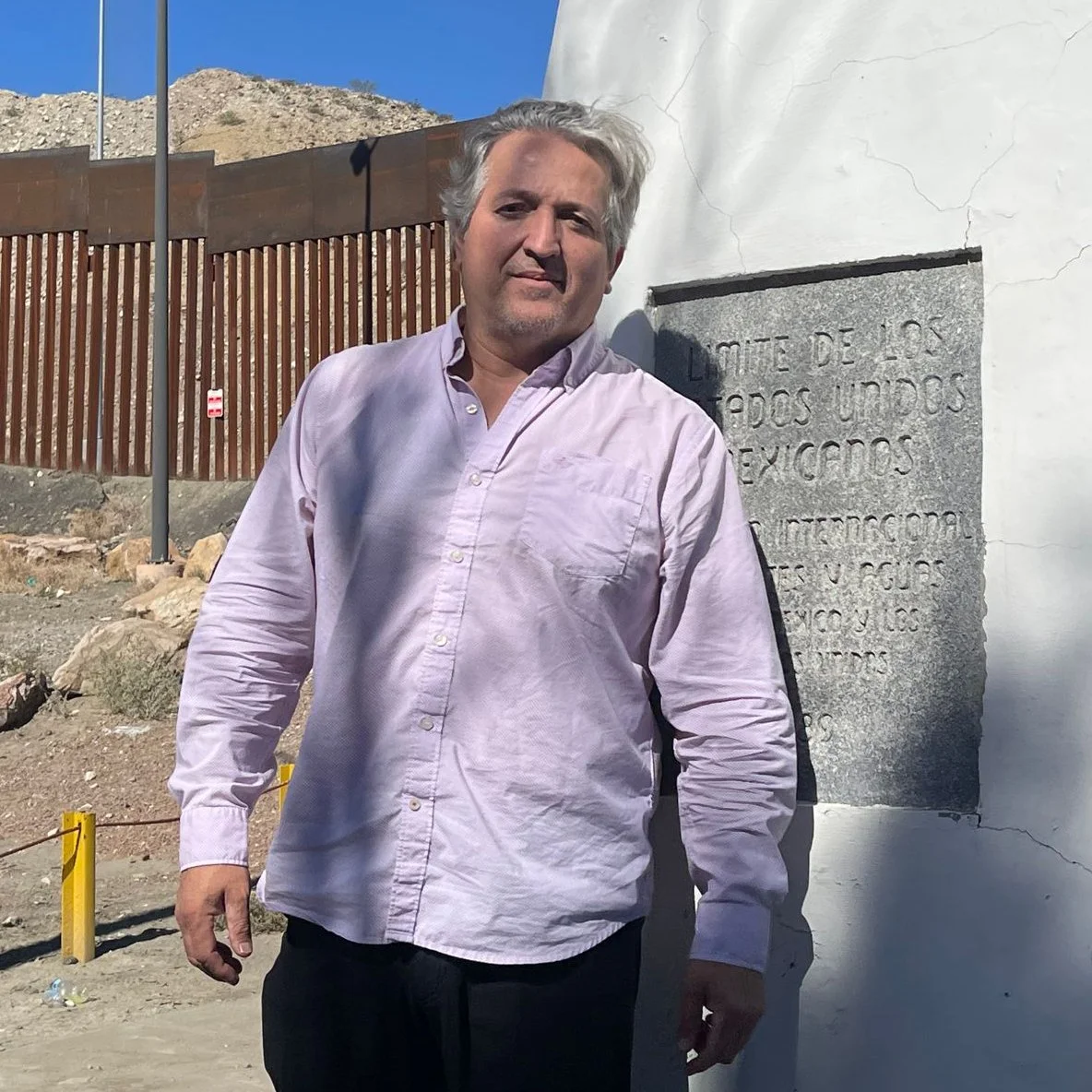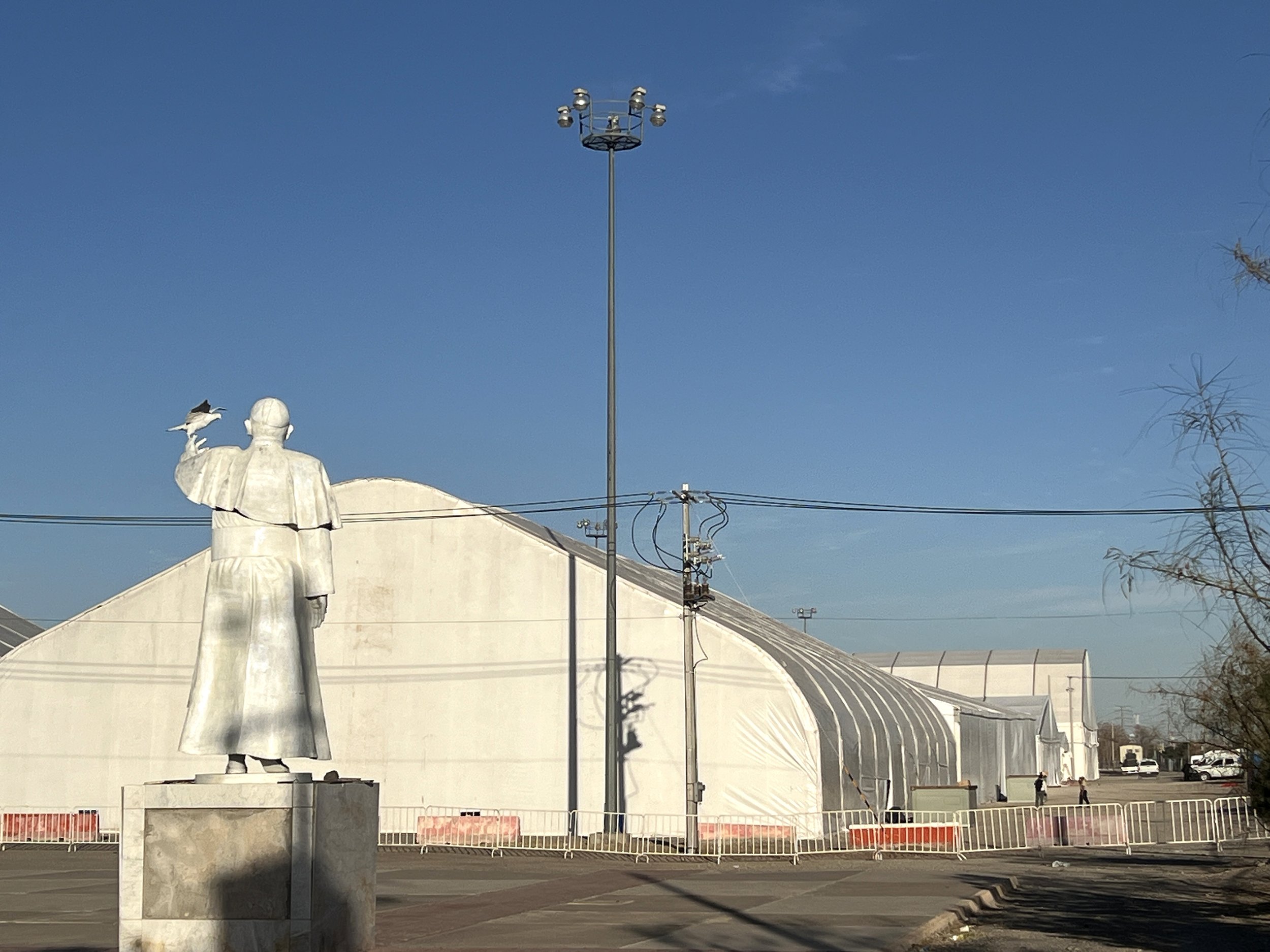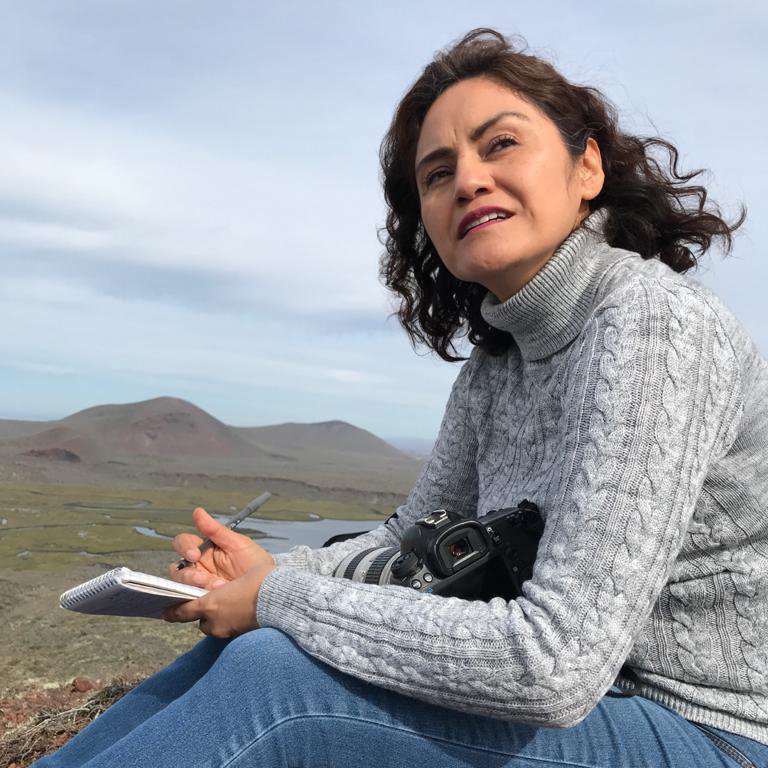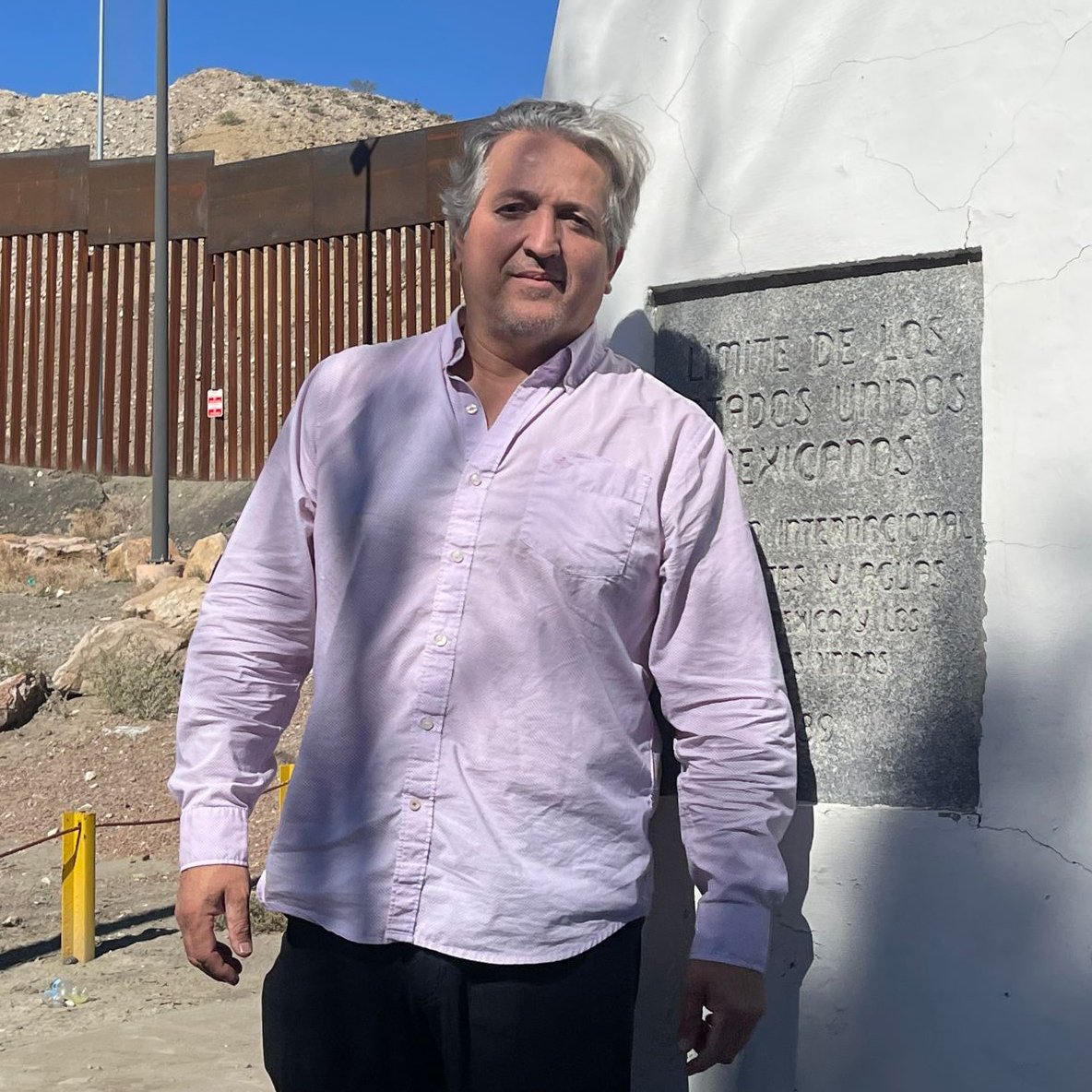Trump’s Mass Deportation Plan Stalls as Mexican Shelters Sit Empty
Senda de Vida II migrant shelter in Reynosa, Tamaulipas, Mexico, on February 7, 2025, can hold more than 2,000 persons. It currently houses only about 100 persons. Photo by Gaige Davila/Puente News Collaborative
No chaos but plenty of anxiety among aid workers, government officials and, of course, immigrant families.
Editor’s note: This story was co-published with Puente News Collaborative in partnership with palabra. Puente News Collaborative is a bilingual nonprofit newsroom, convener and funder dedicated to high-quality, fact-based news and information from the U.S.-Mexico border.
CIUDAD JUÁREZ — Mega shelters for deportees set up by the Mexican government along the border sit mostly empty, one month after President Donald Trump threatened “mass deportations” on Day 1.
The scenes here and in other border cities west in Tijuana and east in Reynosa underscore the setbacks, thus far, of Trump’s promise to launch the largest deportation operation in U.S. history. Trump campaigned to target an estimated 11 million undocumented persons.
Mexican officials along the border, including here in Ciudad Juárez, appear relieved they haven’t seen a swell of deportees, yet.
“We hope there won’t be a large repatriation,” said Secretary of Welfare Ariadna Montiel Reyes, following a tour of a sprawling, empty tent camp that can potentially hold 2,500 deportees. The federal agency is in charge of providing services for Mexicans returned to their home country in a process often called repatriation.
So far, about 2,000 Mexican migrants have set foot in government-operated shelters, said Mexican President Claudia Sheinbaum at her daily press conference. Overall, more than 13,455 migrants have been deported to Mexico, according to Sheinbaum. Among them in a noteworthy negotiation: More than 2,970 migrants from countries other than Mexico, including Cuba and Venezuela, Mexican officials say.
Tents on the south of the border wall in Ciudad Juárez, erected by the Mexican federal government to receive Mexican deportees from the U.S. Photo by Omar Ornelas/El Paso Times/Puente News Collaborative
The numbers of deportees in the last month sent to Mexico were higher than the last four weeks under the previous administration of President Joe Biden, said Ariel G. Ruiz Soto, a senior policy analyst at the nonpartisan Migration Policy Institute.
Deportations have since stabilized, if not actually fallen in pace from the first 10 days of the Trump administration, said Ruiz Soto, who has examined data from both the U.S. and Mexico. “That has a lot to do with the real challenges that ICE (U.S. Immigration and Customs Enforcement) is facing with limited capacity in the interior,” he said, referring to detention space.
ICE has long told Congress it doesn’t have enough funding to detain all the undocumented immigrants that Trump has promised to arrest. Border Czar Tom Homan told CNN Sunday, “I’m not I'm not happy with the numbers, because we got a lot of criminals to find. So what we're talking about right now is increasing the number of teams, (increasing) the targeting…We got to do more.”
ICE, CBP and the Department of Defense didn’t respond to inquiries.
NOGALES
In Nogales, across from Nogales, Arizona, shelters remain empty or with few migrants, said Alma Cota de Yañez, the executive director of Fundación Empresarial Sonorense or FESAC, a nonprofit organization focused on immigrant assistance and border development. “We’re not seeing any chaos in our community,” said Cota de Yañez at a meeting of philanthropic organizations in Mexico City.
Just the same, worries remain with U.S.-Mexico history as a guide. Between 1929 and 1939, about 1 million Mexicans and their U.S.-born children were deported in the so-called “great repatriation,” according to historians in the book “Decade of Betrayal. In 1944, the U.S. government deported an estimated hundreds of thousands and their U.S.-born children, in what was known by the racist name as Operation Wetback. Both operations generated widespread fear and anxiety in the streets of cities, especially those with large Latino populations.
Decades later, the wounds of humiliation remain open, raw, on both sides of the border. For that reason, Mexico is taking no chances — in emotion and practical execution. “México te abraza,” Mexico Hugs You, is the government’s campaign slogan.
At the Juárez shelter, blue and gray mattresses lie inside the camp where flashes of cheerful colors come from the orange, pink and turquoise portable bathrooms outside. Peering over the scene: a larger-than-life statue of Catholic Pope Francis, an immigrant defender, with an outstretched hand releasing a dove. Nearly a decade ago, the statue of the pope was placed at El Punto near the historic Chamizal park on land that ended a U.S.-Mexico boundary dispute.
A statue of Pope Francis overlooks the mega tent shelter in Ciudad Juárez set up for Mexican citizens deported by the Trump administration. The shelter is at El Punto, the location on the border where Pope Francis celebrated a Mass in 2016. Photo by Angela Kocherga/Puente News Collaborative
TIJUANA
In downtown Tijuana, another temporary shelter has sprouted with bunk beds, showers, and a kitchen for migrant stays of just one or two days. The shelter carries the name: Juventud 2000.
The shelters’ residents share something whether in the state of Baja California, Chihuahua or Tamaulipas: migrants with no options to gain asylum in the U.S. or gain lawful U.S. entry with a now-defunct mobile phone app.
Some Mexican migrants said they would remain in Tijuana, banking on a reversal in Trump’s policies. That’s deepening concerns about overwhelming border communities in the coming weeks and months. The Sheinbaum government is handing out $97 debit cards to encourage migrants to return to hometowns in the interior of the country.
‘Maybe they're holding onto some hope that something might work out, but probably it's going to be 4 years before there's any significant pathways.’
Consider Matías Ezequiel, 35. "Our hope ended when Trump took office, but we are from Puebla, and there is a lot of violence there,” he said. “My children were threatened — we are definitely not going back."
Some migrants will opt to jump the wall in Tijuana, or take a speed boat through the water, migrants said. Others take mountain routes through the nearby city of Tecate to the east. Yet others use other people’s visas to cross through vehicular checkpoints.
In Tijuana, the prices charged by coyotes have doubled, according to migrants. The cost for these crossings ranges from $6,000 to $10,000, a doubling of fees. But coyotes scramble for business in other cities, including Juárez where prices have dropped due to falling demand, said humanitarian workers at migrant nonprofits.
Tables set up to assist incoming deportees at a migrant center in Tijuana, Baja California. Image courtesy of the State of Baja California
REYNOSA
Similarly, in Reynosa, migrants have retreated to shelters or are sleeping on the streets. In Senda de Vida 2, one of the city’s largest private shelters, around 100 people live in limbo, though about 2,500 persons can fit there.
At Casa del Migrante Nuestra Señora de Guadalupe, a smaller private shelter, Mexican nationals, deported after ICE raids from the last couple weeks, have sought refuge there. About 160 or so migrants, mostly Mexicans worried about security in their home states, currently shelter there behind heavy doors at the compound.
“The people that are there, what else are they gonna do?” said Kevin McNamara, the executive director of 13:2 Initiative, a Texas-based organization that distributes donations to shelters.
“Maybe they're holding onto some hope that something might work out, but probably it's going to be 4 years before there's any significant pathways,” he said.
Migrants being escorted by Mexican immigration police into Reynosa, Tamaulipas, Mexico, on February 7, 2025. Photo by Gaige Davila/Puente News Collaborative
DEL RIO
Ironically, the only large-scale arrival of newcomers on the border appears to be the hundreds of military troops on both sides. Sheinbaum sent an additional 10,000 national guard troops to Mexican border states. Some join members of the Mexican military to search for clandestine tunnels used for smuggling and U.S. bound vehicles for fentanyl, a desperate search fueled by Trump’s threats of imposing 25% tariffs on Mexican imports, which would hurt U.S. consumers.
On the U.S. side, the Trump administration has deployed 1,500 additional troops adding to the 2,500 that have been on the southern U.S. border already to provide support for the U.S. Border Patrol.
In Del Rio, some U.S. military members in hotels already crammed with Texas troopers, leave some locals perplexed in communities considered among the safest in the United States.
“Just as a community member, I'm not seeing them in their military uniforms,” said Tiffany Burrow, who runs the nonprofit Val Verde Humanitarian Border Coalition. “I'm seeing them off duty, walking up and down our Main Street, going to Chick-Fil-A, or Whataburger.” She said the flow of migrants seeking help dived from about 89 per day in early January to zero.
U.S. National Guard member below the McAllen/Hidalgo International Bridge on February 7, 2025. The Trump administration has deployed 1500 additional troops adding to the 2,500 that have been along the southern U.S. border. Photo by Gaige Davila/Puente News Collaborative
EL PASO
Somewhere between the powerful economic and cultural forces that bind two countries and two border cities lies frayed nerves and confusion. At the shelters and elsewhere, social media agitates the public further. In El Paso, a county of more than 950,000 residents, more than 80% of the population is Latino. Here, it seems, everyone is suspected of being undocumented.
A recent video shows agents wearing vests with the logos of the U.S. Border Patrol asking a group of English-speaking young men at a horse training facility about their citizenship. One armed agent demands proof.
Support the voices of independent journalists.
|
“I’m a U.S. citizen, just to clarify, born in El Paso, Texas,” the young man answered.
U.S. Border Patrol would not comment on the video, citing an investigation. But Border Patrol agent Orlando Marrero-Rubio said agents “are not randomly asking people for immigration papers.” Anti-smuggling and intelligence units carry out targeted enforcement involving a specific suspect and have a warrant, he said.
The video and people present when the agents arrived suggest otherwise. They say the men never presented a warrant to enter private property. At the horse stables, a worker named Ventura, who declined to provide his surname, summed up his emotions in Spanish about deportations.
“Estamos muy tristes,” Ventura said. “Nos sentimos acorralados. No por los caballos, pero la migra.”
(“We are very sad. We feel corralled. Not by the horses but by immigration agents.”)
—
Alfredo Corchado is the executive editor for Puente News Collaborative and the former Mexico/Border Correspondent for The Dallas Morning News. He’s the author of “Midnight in Mexico” and “Homelands.” He graduated from the University of Texas at El Paso and was a Nieman Fellow at Harvard. @ajcorchado
Angela Kocherga is an award-winning multimedia journalist who has dedicated her career to reporting about the Southwest border and Mexico. In 2019 she earned a Maria Moors Cabot Prize from Columbia University for courageous reporting in Latin America. She served as Mexico bureau chief and border correspondent for a group of U.S. television stations. Kocherga currently is news director for public radio station KTEP in El Paso and contributes stories to the Texas Newsroom and NPR.. @AngelaKBorder
Gaige Davila is a freelance journalist based in the Rio Grande Valley. His reporting has been published in The Texas Observer, Deceleration, Texas Public Radio, MySA.com, the San Antonio Current, NPR, the Guardian, Mother Jones and more. @GaigeDavila
Aline Corpus Simerman is a Mexican freelance journalist who covers the northern border based in Tijuana and Mexicali. She’s covered the start of the drug war, immigration, forced displacement, the human rights of indigenous, and migrants workers and climate change. @alinecorpus
Omar Ornelas is a Mexican photojournalist based in Ciudad Juárez, Mexico. For the last 20 years, he has been reporting on and photographing farmworker labor, education, health and housing issues in California, Texas and Arizona, as well as border security and Mexican and Central American migratory flows at the U.S.-Mexico border, for the USA TODAY Network. @fotornelas
Dianne Solis is a freelance journalist. She has worked as a staff writer for The Dallas Morning News and The Wall Street Journal. Her work has been featured on KERA public radio, the Texas Standard and the Texas Observer. She has reported extensively on immigration for decades. She graduated from Northwestern and California State University, Fresno, and was a Nieman Fellow at Harvard. @disolis






